key battery Hyundai Sonata
[x] Cancel search | Manufacturer: HYUNDAI, Model Year: , Model line: , Model:Pages: 208, PDF Size: 16.93 MB
Page 20 of 208
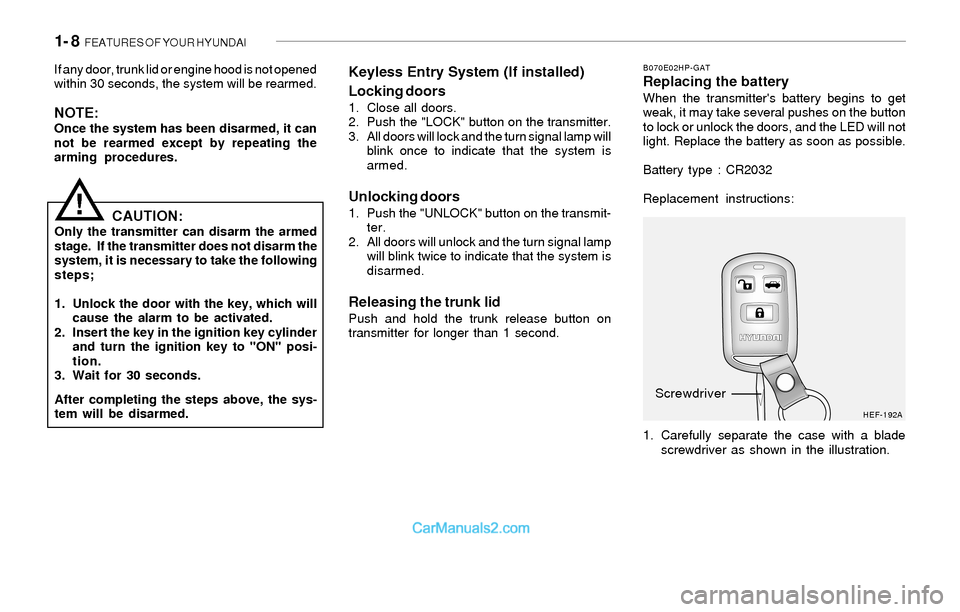
1- 8 FEATURES OF YOUR HYUNDAI
B070E02HP-GATReplacing the batteryWhen the transmitter's battery begins to get
weak, it may take several pushes on the button
to lock or unlock the doors, and the LED will not
light. Replace the battery as soon as possible.
Battery type : CR2032
Replacement instructions:
1. Carefully separate the case with a blade
screwdriver as shown in the illustration. If any door, trunk lid or engine hood is not opened
within 30 seconds, the system will be rearmed.NOTE:Once the system has been disarmed, it can
not be rearmed except by repeating the
arming procedures.
CAUTION:Only the transmitter can disarm the armed
stage. If the transmitter does not disarm the
system, it is necessary to take the following
steps;
1. Unlock the door with the key, which will
cause the alarm to be activated.
2. Insert the key in the ignition key cylinder
and turn the ignition key to "ON" posi-
tion.
3. Wait for 30 seconds.
After completing the steps above, the sys-
tem will be disarmed.
Keyless Entry System (If installed)
Locking doors
1. Close all doors.
2. Push the "LOCK" button on the transmitter.
3. All doors will lock and the turn signal lamp will
blink once to indicate that the system is
armed.
Unlocking doors1. Push the "UNLOCK" button on the transmit-
ter.
2. All doors will unlock and the turn signal lamp
will blink twice to indicate that the system is
disarmed.
Releasing the trunk lidPush and hold the trunk release button on
transmitter for longer than 1 second.
HEF-192A
!
Screwdriver
Page 21 of 208
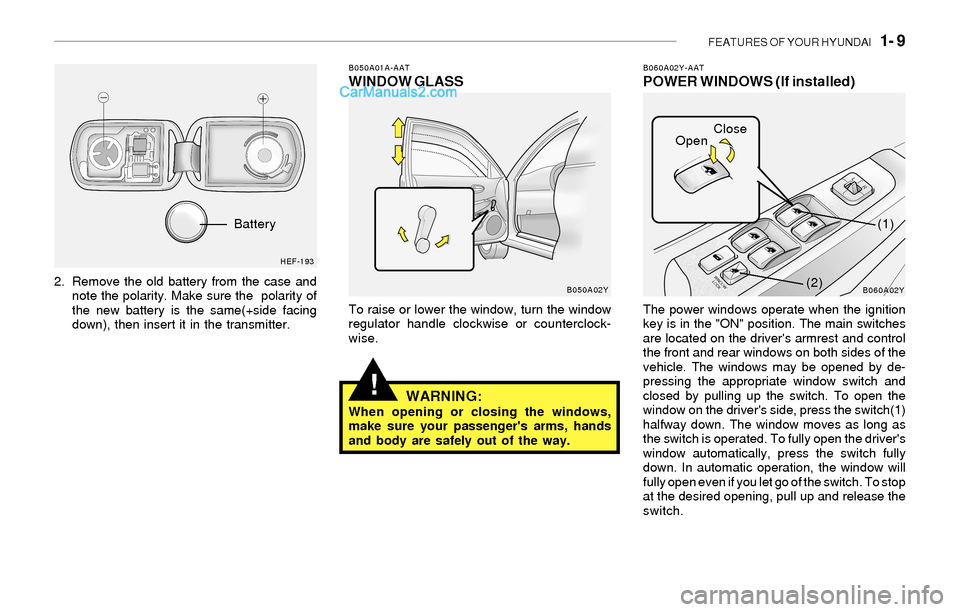
FEATURES OF YOUR HYUNDAI 1- 9
!
2. Remove the old battery from the case and
note the polarity. Make sure the polarity of
the new battery is the same(+side facing
down), then insert it in the transmitter.
B050A01A-AATWINDOW GLASS
To raise or lower the window, turn the window
regulator handle clockwise or counterclock-
wise.
WARNING:When opening or closing the windows,
make sure your passenger's arms, hands
and body are safely out of the way.
B060A02Y-AATPOWER WINDOWS (If installed)
The power windows operate when the ignition
key is in the "ON" position. The main switches
are located on the driver's armrest and control
the front and rear windows on both sides of the
vehicle. The windows may be opened by de-
pressing the appropriate window switch and
closed by pulling up the switch. To open the
window on the driver's side, press the switch(1)
halfway down. The window moves as long as
the switch is operated. To fully open the driver's
window automatically, press the switch fully
down. In automatic operation, the window will
fully open even if you let go of the switch. To stop
at the desired opening, pull up and release the
switch.
HEF-193
B050A02Y
B060A02Y
Battery(1) Close
Open
(2)
Page 42 of 208
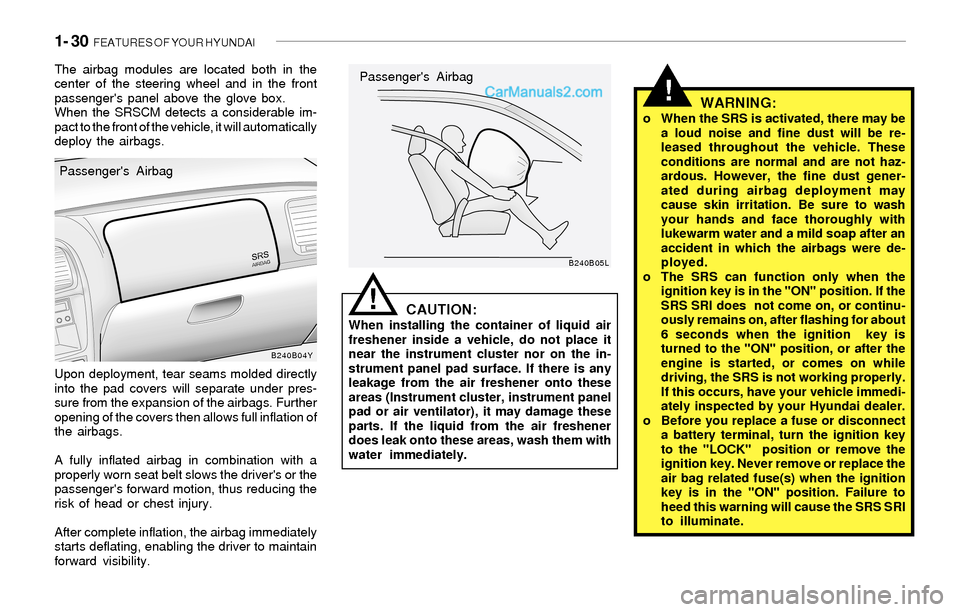
1- 30 FEATURES OF YOUR HYUNDAI
!
The airbag modules are located both in the
center of the steering wheel and in the front
passenger's panel above the glove box.
When the SRSCM detects a considerable im-
pact to the front of the vehicle, it will automatically
deploy the airbags.
Upon deployment, tear seams molded directly
into the pad covers will separate under pres-
sure from the expansion of the airbags. Further
opening of the covers then allows full inflation of
the airbags.
A fully inflated airbag in combination with a
properly worn seat belt slows the driver's or the
passenger's forward motion, thus reducing the
risk of head or chest injury.
After complete inflation, the airbag immediately
starts deflating, enabling the driver to maintain
forward visibility.
CAUTION:When installing the container of liquid air
freshener inside a vehicle, do not place it
near the instrument cluster nor on the in-
strument panel pad surface. If there is any
leakage from the air freshener onto these
areas (Instrument cluster, instrument panel
pad or air ventilator), it may damage these
parts. If the liquid from the air freshener
does leak onto these areas, wash them with
water immediately.
WARNING:o When the SRS is activated, there may be
a loud noise and fine dust will be re-
leased throughout the vehicle. These
conditions are normal and are not haz-
ardous. However, the fine dust gener-
ated during airbag deployment may
cause skin irritation. Be sure to wash
your hands and face thoroughly with
lukewarm water and a mild soap after an
accident in which the airbags were de-
ployed.
o The SRS can function only when the
ignition key is in the "ON" position. If the
SRS SRI does not come on, or continu-
ously remains on, after flashing for about
6 seconds when the ignition key is
turned to the "ON" position, or after the
engine is started, or comes on while
driving, the SRS is not working properly.
If this occurs, have your vehicle immedi-
ately inspected by your Hyundai dealer.
o Before you replace a fuse or disconnect
a battery terminal, turn the ignition key
to the "LOCK" position or remove the
ignition key. Never remove or replace the
air bag related fuse(s) when the ignition
key is in the "ON" position. Failure to
heed this warning will cause the SRS SRI
to illuminate.
!
B240B04YB240B05L
Passenger's AirbagPassenger's Airbag
Page 118 of 208
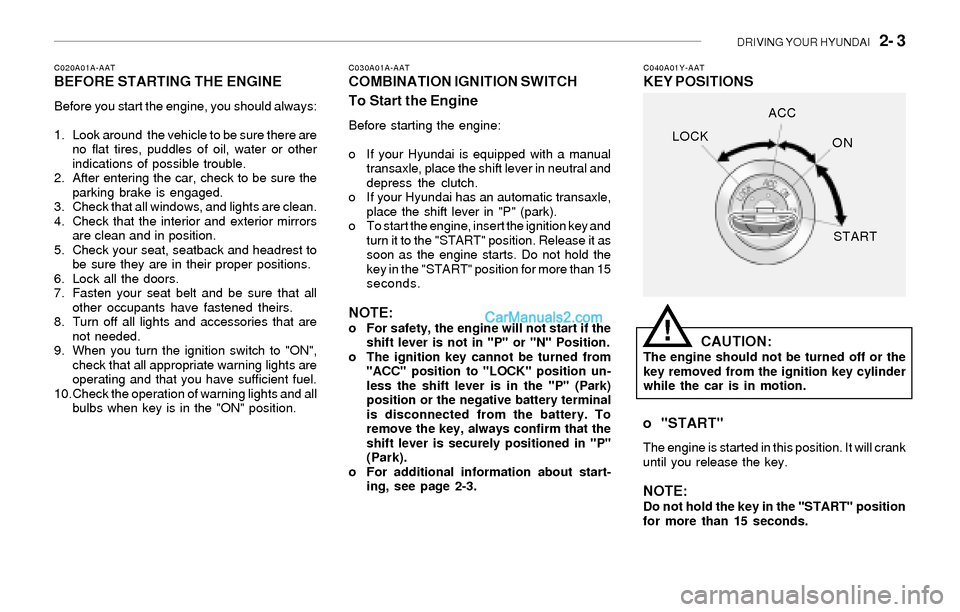
DRIVING YOUR HYUNDAI 2- 3
C020A01A-AATBEFORE STARTING THE ENGINE
Before you start the engine, you should always:
1. Look around the vehicle to be sure there are
no flat tires, puddles of oil, water or other
indications of possible trouble.
2. After entering the car, check to be sure the
parking brake is engaged.
3. Check that all windows, and lights are clean.
4. Check that the interior and exterior mirrors
are clean and in position.
5. Check your seat, seatback and headrest to
be sure they are in their proper positions.
6. Lock all the doors.
7. Fasten your seat belt and be sure that all
other occupants have fastened theirs.
8. Turn off all lights and accessories that are
not needed.
9. When you turn the ignition switch to "ON",
check that all appropriate warning lights are
operating and that you have sufficient fuel.
10.Check the operation of warning lights and all
bulbs when key is in the "ON" position.
C030A01A-AATCOMBINATION IGNITION SWITCH
To Start the Engine
Before starting the engine:
o If your Hyundai is equipped with a manual
transaxle, place the shift lever in neutral and
depress the clutch.
o If your Hyundai has an automatic transaxle,
place the shift lever in "P" (park).
o To start the engine, insert the ignition key and
turn it to the "START" position. Release it as
soon as the engine starts. Do not hold the
key in the "START" position for more than 15
seconds.
NOTE:o For safety, the engine will not start if the
shift lever is not in "P" or "N" Position.
o The ignition key cannot be turned from
"ACC" position to "LOCK" position un-
less the shift lever is in the "P" (Park)
position or the negative battery terminal
is disconnected from the battery. To
remove the key, always confirm that the
shift lever is securely positioned in "P"
(Park).
o For additional information about start-
ing, see page 2-3.
C040A01Y-AATKEY POSITIONS
CAUTION:
The engine should not be turned off or the
key removed from the ignition key cylinder
while the car is in motion.
!
o "START"
The engine is started in this position. It will crank
until you release the key.
NOTE:Do not hold the key in the "START" position
for more than 15 seconds.LOCKACC
ON
START
Page 119 of 208

2- 4 DRIVING YOUR HYUNDAI
!
C070C02A-AATTo Remove the Ignition KeyC050A01A-AATSTARTING o "ON"When the key is in the "ON" position, the ignition
is on and all accessories may be turned on. If
the engine is not running, the key should not be
left in the "ON" position. This will discharge the
battery and may also damage the ignition sys-
tem.
o "ACC"
With the key in the "ACC" position, radio and
other accessories may be operated. If you open
the driver's door with the key in the "ACC" or
"LOCK" position, the chime will sound to remind
you that the key should be removed.
o "LOCK"
The key can be removed or inserted in this
position. Steering is locked by removing the
key. When unlocking the steering, insert the
key, and then turn the steering wheel and key
simultaneously.
NOTE:To unlock the steering wheel, insert the key,
and then turn the steering wheel and key
simultaneously.(If your vehicle is equipped with an automatic
transaxle)
1. Turn the ignition key counterclockwise from
the "ACC" position to the "LOCK" position.
2. The key can be removed in the "LOCK"
position.
(If your vehicle is equipped with a manual
transaxle)
1. Turn the ignition key to the "ACC" position.
2. Simultaneously push and turn the ignition
key counterclockwise from the "ACC"
position to the "LOCK" position.
3. The key can be removed in the "LOCK"
position.
WARNING:Never run the engine in a closed or poorly
ventilated area any longer than is needed to
move your car in or out of the area. The
carbon monoxide gas emitted is odorless
and can cause serious injury or death.
C070C01E-1
C050A01E-1
LOCKACC
ON
STARTLOCK
ON
START
Page 129 of 208

2- 14 DRIVING YOUR HYUNDAI
C160G01A-AATTo Keep Locks from Freezing
To keep the locks from freezing, squirt an
approved de-icer fluid or glycerine into the key
opening. If a lock is covered with ice, squirt it with
an approved de-icing fluid to remove the ice. If
the lock is frozen internally, you may be able to
thaw it out by using a heated key. Handle the
heated key with care to avoid burning the
fingers.
C160D01A-AAT
Check Battery and Cables
Winter puts additional burdens on the battery
system. Visually inspect the battery and cables
as described in Section 6. The level of charge
in your battery can be checked by your Hyundai
dealer or a service station.
C160F01A-AATCheck Spark Plugs and Ignition
System
Inspect your spark plugs as described in Sec-
tion 6 and replace them if necessary. Also
check all ignition wiring and components to be
sure they are not cracked, worn or damaged in
any way.
C160E01A-AATChange to "Winter Weight" Oil if
Necessary
In some climates it is recommended that a lower
viscosity "winter weight" oil be used during cold
weather. See Section 9 for recommendations.
If you aren't sure what weight oil you should use,
consult your Hyundai dealer.
C160C01A-AATUse High Quality Ethylene Glycol
Coolant
Your Hyundai is delivered with high quality
ethylene glycol coolant in the cooling system. It
is the only type of coolant that should be used
because it helps prevent corrosion in the cool-
ing system, lubricates the water pump and
prevents freezing. Be sure to replace or replen-
ish your coolant in accordance with the main-
tenance schedule in Section 5. Before winter,
have your coolant tested to assure that its
freezing point is sufficient for the temperatures
anticipated during the winter.
C160B01A-AATSnowy or Icy Conditions
To drive your vehicle in deep snow, it may be
necessary to use snow tires or to install tire
chains on your tires. If snow tires are needed,
it is necessary to select tires equivalent in size
and type of the original equipment tires. Failure
to do so may adversely affect the safety and
handling of your car. Furthermore, speeding,
rapid acceleration, sudden brake applications,
and sharp turns are potentially very hazardous
practices.
During deceleration, use engine braking to the
fullest extent. Sudden brake applications on
snowy or icy roads may cause skids to occur.
You need to keep sufficient distance between
the vehicle in operation in front and your vehicle.
Also, apply the brake gently. It should be noted
that installing tire chains on the tire will provide
a greater driving force, but will not prevent side
skids.
NOTE:Tire chains are not legal in all states. Check
state laws before fitting tire chains.
Page 204 of 208
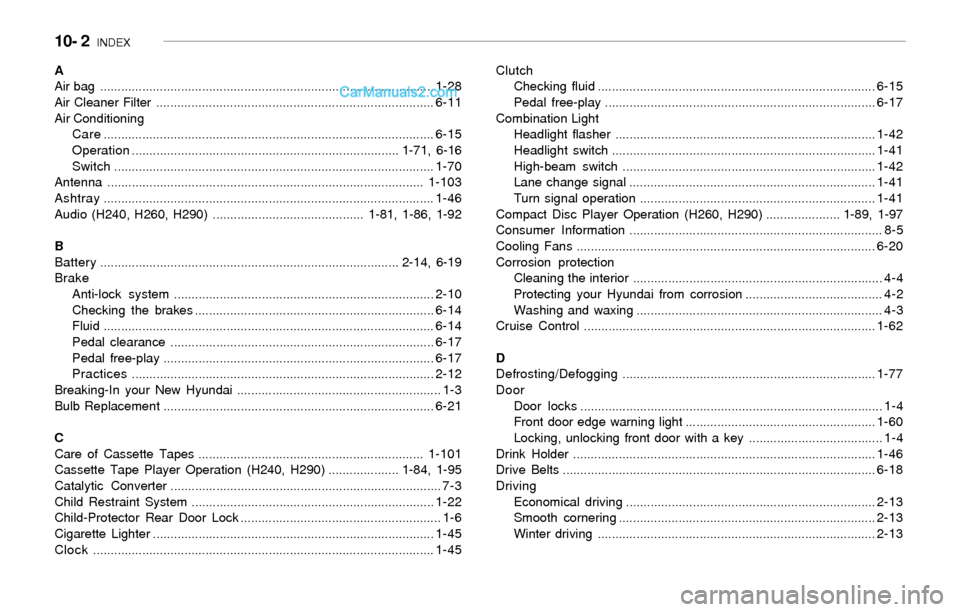
10- 2 INDEX
A
Air bag ...............................................................................................1-28
Air Cleaner Filter ...............................................................................6-11
Air Conditioning
Care..............................................................................................6-15
Operation............................................................................ 1-71, 6-16
Switch...........................................................................................1-70
Antenna..........................................................................................1-103
Ashtray..............................................................................................1-46
Audio (H240, H260, H290)........................................... 1-81, 1-86, 1-92
B
Battery..................................................................................... 2-14, 6-19
Brake
Anti-lock system..........................................................................2-10
Checking the brakes ....................................................................6-14
Fluid ..............................................................................................6-14
Pedal clearance...........................................................................6-17
Pedal free-play.............................................................................6-17
Practices......................................................................................2-12
Breaking-In your New Hyundai .......................................................... 1-3
Bulb Replacement.............................................................................6-21
C
Care of Cassette Tapes ................................................................1-101
Cassette Tape Player Operation (H240, H290) .................... 1-84, 1-95
Catalytic Converter............................................................................. 7-3
Child Restraint System.....................................................................1-22
Child-Protector Rear Door Lock ......................................................... 1-6
Cigarette Lighter................................................................................1-45
Clock .................................................................................................1-45Clutch
Checking fluid...............................................................................6-15
Pedal free-play.............................................................................6-17
Combination Light
Headlight flasher..........................................................................1-42
Headlight switch...........................................................................1-41
High-beam switch........................................................................1-42
Lane change signal ......................................................................1-41
Turn signal operation...................................................................1-41
Compact Disc Player Operation (H260, H290) ..................... 1-89, 1-97
Consumer Information........................................................................ 8-5
Cooling Fans.....................................................................................6-20
Corrosion protection
Cleaning the interior....................................................................... 4-4
Protecting your Hyundai from corrosion....................................... 4-2
Washing and waxing...................................................................... 4-3
Cruise Control...................................................................................1-62
D
Defrosting/Defogging........................................................................1-77
Door
Door locks...................................................................................... 1-4
Front door edge warning light ......................................................1-60
Locking, unlocking front door with a key ...................................... 1-4
Drink Holder ......................................................................................1-46
Drive Belts.........................................................................................6-18
Driving
Economical driving .......................................................................2-13
Smooth cornering.........................................................................2-13
Winter driving...............................................................................2-13